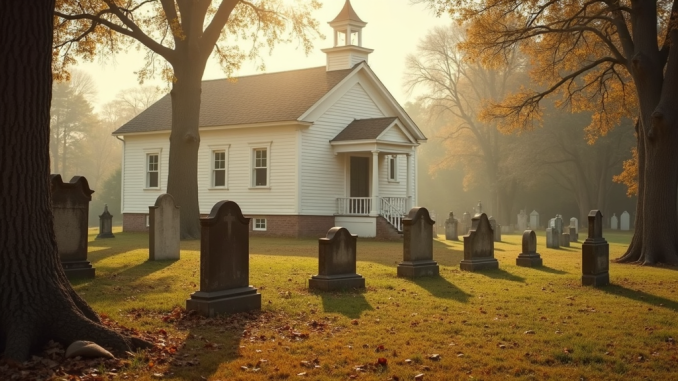
Mt Carmel Baptist Church cemetery records are a gateway to family history and local memory, inviting researchers to explore headstone inscriptions, plot layouts, and church ledgers. Alongside Mt Carmel Baptist Church cemetery transcription projects, you’ll encounter birth and death dates, family relationships, and occasionally occupation clues that help identify ancestors. In this guide, Mt Carmel Baptist Church cemetery records are explored alongside church minutes, cemetery plot maps, and local history cemetery records to help you find ancestors and situate burials within the community’s story. The guide emphasizes a practical workflow, reliable sources, and verification strategies for finding ancestors and building credible, well-sourced family histories, including church cemetery records as a core resource. By combining online databases, local archives, and direct outreach to church staff, you can connect clues into a coherent narrative tied to the Mt Carmel community.
From a semantic perspective, approach these records as churchyard records, burial ledgers, and interment indexes that illuminate who rests here and when. Headstone inscriptions, memorial cards, cemetery maps, and plot indexes become the data points in a larger local genealogy narrative. This LSI framing helps search engines connect related terms like tombstone data, interment records, and parish histories, improving discoverability for researchers seeking lineage and local history. By using synonyms and related terms, you can broaden searches, verify dates with corroborating records, and build a cohesive picture of families across generations.
Mt Carmel Baptist Church cemetery records: Understanding scope and types
Mt Carmel Baptist Church cemetery records span multiple record types that together illuminate a community’s past. You may encounter headstone inscriptions, burial registers, plot maps, church minutes, sexton logs, and cemetery maintenance records. Each form offers distinct clues: birth and death dates on headstones; burial dates and plot numbers in ledgers; map layouts that reveal family plots; minutes that record land purchases or section additions. Accumulating these bits of evidence helps you build a richer picture of the people and the local history they inhabited.
Understanding the scope of Mt Carmel Baptist Church cemetery records is essential for a focused search. Because collections vary by location and era, a disciplined approach—combining online databases, local archives, and direct outreach—maximizes your chances of turning names into stories and place into context within local history cemetery records.
Getting started: pinpointing the exact Mt Carmel Baptist Church Cemetery
Begin with precise location details: state, county, city, and any known neighborhood. The name Mt Carmel Baptist Church is shared by many communities, and small spelling variations (Mt. Carmel, Mount Carmel) can steer you toward different record sets.
Use targeted searches that include cemetery plot maps and related terms, and prepare to expand to adjacent church properties or community cemeteries when records reference associated parcels. This early scoping aligns with the goal of finding ancestors and locating local history cemetery records that contextualize a burial.
Interpreting headstone inscriptions to illuminate kinship and life events
Headstone inscriptions are a primary gateway into family relationships, life spans, and sometimes occupations. Transcribed text can reveal spouse names, parents, and other kin, providing anchor dates for census data and obituaries.
Pair headstone data with obituary notices, civil vital records, and church minutes to corroborate relationships. This descriptive approach helps you move from a name on a stone to a person with a story, enriching your research for church cemetery records and local history cemetery records.
Plot maps and cemetery layout: tracing generations through the grounds
Cemetery plot maps visualize the physical arrangement of family plots, sections, and transfers over time. Reading these maps helps you connect siblings, spouses, and parent–child relationships across generations and identify how a burial fits within a community cemetery.
When possible, compare plot map positions with church ledgers or sexton notes to confirm plot ownership and movement. This cross-check supports more confident conclusions about your ancestors and strengthens the local history cemetery records you assemble.
Church minutes, sextons, and provenance: building a credible narrative
Minutes of the church and cemetery committee often document sales, transfers, dedications, and expansions that shed light on when a burial occurred. Sexton ledgers may list interments by date and plot, and notes about interments can help date events not recorded elsewhere.
Document your provenance carefully: record source names, dates, and branches of evidence. Cross-referencing these church cemetery records with civil records and obituaries improves reliability and reveals broader community patterns in Mt Carmel’s history.
Digital resources and local archives: from Mt Carmel Baptist Church cemetery transcription to shared history
Online transcription projects and databases—Find A Grave, BillionGraves, Interment.net, and FamilySearch—offer searchable indexes, photos, and sometimes full Mt Carmel Baptist Church cemetery transcription, as well as related records. Use these tools to bootstrap your research and identify potential leads for deeper verification.
Local archives, historical societies, and county libraries host cemetery plot maps, parish registers, and microfilmed church minutes that aren’t always digitized. A strategic plan combining online discovery with on-site or archival outreach will expand your ability to find ancestors and assemble a robust local history cemetery records narrative.
Frequently Asked Questions
What are Mt Carmel Baptist Church cemetery records and how can they help you find ancestors?
Mt Carmel Baptist Church cemetery records include headstone inscriptions, burial registers, plot maps, and related church documents. They offer birth and death dates, family relationships, plot locations, and ownership notes that help in finding ancestors. Start with online databases such as Find A Grave, Interment.net, and FamilySearch, then contact the church for sexton ledgers or cemetery minutes. Cross-check with obituaries and censuses to verify connections.
How can cemetery plot maps in Mt Carmel Baptist Church cemetery records help illuminate local history?
Cemetery plot maps show the physical layout, family plots, and changes over time, helping place burials in a local history context. Use maps with church minutes and sexton logs to date sections or plot transfers. Compare maps with genealogical records to confirm kin relationships. Search local archives for interlinked maps and plot designations.
Where can I find Mt Carmel Baptist Church cemetery transcription and related church cemetery records online?
Online sources like Find A Grave, BillionGraves, Interment.net, and FamilySearch often host Mt Carmel Baptist Church cemetery transcription projects or links to parish records. Search variations of ‘Mt Carmel’ and consider related local cemeteries. Local historical societies and county archives may host scans of church minutes and plot lists.
How can I use Mt Carmel Baptist Church cemetery records for finding ancestors?
Begin by locating the exact Mt Carmel Baptist Church (state/county). Use headstone inscriptions for birth/death dates and kinship, then consult burial registers for dates and plot numbers. Cross-check with obituaries, census records, and church minutes for family connections. Build a source-tracked timeline to verify ancestors across records.
What is the role of local history cemetery records in interpreting Mt Carmel Baptist Church cemetery records?
Local history records provide context: migration patterns, church activities, and property changes that explain why and when burials occurred. Cross-reference cemetery records with local histories, newspapers, and church minute books. Plot maps combined with local histories reveal community networks and family clusters.
What is a practical workflow for working with Mt Carmel Baptist Church cemetery records and cemetery plot maps?
1) Define the Mt Carmel location and time range. 2) List known relatives. 3) Search online databases using church name and variations. 4) Request church cemetery records and plot maps. 5) Check local archives and newspapers. 6) Compile a source-tracked genealogy sheet. 7) Validate connections with multiple records and document name spellings. 8) Share your findings with family or local historical groups.
| Topic Area | Key Points | Notes / Examples |
|---|---|---|
| Purpose of Mt Carmel Baptist Church cemetery records | Serve as gateway to family heritage and local history; a chronological ledger of births, marriages, deaths, and social fabric | Not just names—contextual clues about migration and community life. |
| Types of records | Headstone inscriptions; burial registers/sexton ledgers; plot maps; church minutes and cemetery records | Each type provides different clues. |
| What each type reveals | Birth/death dates, relationships; burial dates and arrangers; plot layout and family plots; ownership and section changes | Look for epitaphs, dates, plot numbers. |
| Identify the exact church and scope | Determine precise Mt Carmel Baptist Church (state/county/city); variations in name matter | Use local landmarks and county records to contextualize. |
| Online resources to begin | Find A Grave, BillionGraves, Interment.net; FamilySearch; local societies; newspapers | Search by church name/location; consider date filters. |
| Access strategies | Contact church office or sexton; visit for on-site or request digitized copies; libraries and archives | Ask for ledgers, maps, scans. |
| Cross-referencing for accuracy | Corroborate dates/relationships with obituaries, census, vital records | Use multiple sources to confirm each entry. |
| Practical workflow | Define scope; gather relatives; search online; check church records; explore archives; use obituaries; compile and validate; preserve | Follow a repeatable process. |
| Tools, tips and best practices | Name variations; document provenance; consider inter-cemetery connections; use search operators; respect privacy | Keep track of spellings; cite sources. |
| Local history context | Cemetery records illuminate migration, religion, economy, social networks | Compare with local histories to build broader context. |
Summary
Table presents key points from the base content about Mt Carmel Baptist Church cemetery records in a structured, digestible format.
Introducing Autowp, your AI content generator and AI content creator for WordPress — a cutting-edge plugin that empowers you to auto-create and optimize content directly inside WordPress, helping you scale publishing rates, improve SEO, and captivate readers with AI-powered drafts, outlines, and edits. Seamlessly integrated, Autowp delivers fast, relevant content, enables keyword-focused optimization, and supports multiple languages for global audiences, all while keeping editing in your workflow. Ready to boost productivity? Try Autowp today at Autowp and see how an AI content generator and AI content creator can transform your WordPress site into a high-performing content hub. To remove this promotional paragraph, upgrade to Autowp Premium membership.

Leave a Reply